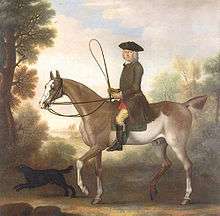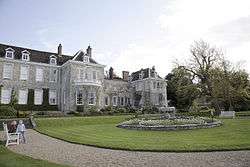Thomas Gage, 1st Viscount Gage
Thomas Gage, 1st Viscount Gage (c. 1695 – 21 December 1754) of High Meadow, Gloucestershire and later Firle Place, Sussex, was a British landowner and politician who sat in the House of Commons for 33 years between 1717 and 1754.

Early life
Gage was the eldest son of Joseph Gage of Sherborne Castle and Elizabeth Penruddock, the daughter and heiress of Sir George Penruddock. He succeeded his father-in-law to High Meadow in 1714. Under a marriage settlement dated 3 October 1713, he married Benedicta Maria Theresa Hall, daughter and heiress of Henry Benedict Hall of High Meadow, Gloucestershire and his wife Frances Fortescue.[1] He converted to the Church of England in 1715, perhaps to enable him to sit in parliament.[2]
Career
Gage was elected Member of Parliament for Minehead at a by-election on 11 April 1717, but was unseated on petition on 23 May 1717. On 14 September 1720, King George I created him Baron Gage of Castlebar in the county of Mayo, and Viscount Gage of Castle Island in the county of Kerry of the Kingdom of Ireland.[1]
Gage was elected MP for Tewkesbury at a by-election on 25 October 1721 and was elected again at the 1722 general election. In his first session of this parliament, he made several speeches against the special tax on Papists. In April 1727 he spoke for the motion for a vote of credit. He was returned again at the 1727 general election. He exposed the fraudulent sale of the Derwentwater estates on 31 March 1732, and was subsequently rewarded with £2,000 for this under the Greenwich Hospital Act 1735.[3] At the 1734 general election, he was returned again as MP for Tewkesbury. He introduced a bill to prevent clandestine marriages, in 1736, but it was rejected. In 1738, it was rumoured that he was to be appointed as Governor of Barbados, but the appointment was never materialised,[1] probably because he lacked sufficient political connections.[4] He went into opposition with Pulteney in 1739, but in February 1741, he was one of the opposition Whigs who withdrew on the motion for Walpole's removal. He was returned to parliament again at the 1741 general election.[1]

On 23 April 1744, his cousin, Sir William Gage, 7th Baronet, died without children, and Gage inherited the baronetcy and the family estate of Firle Place. Sir William's late father was Gage's uncle - Sir John Gage, 4th Baronet, Sheriff of Sussex. The main line of the family, up to the 7th Baronet, had been Roman Catholic recusants who had purchased their baronetcy from King James I, and Gage quietly resumed practising Roman Catholicism, although his children were raised in the Church of England. At the 1747 general election, he was returned again for Tewkesbury and joined the opposition. In 1747 was appointed Steward of the Household of Frederick, Prince of Wales and held the post until 1751.[1]
Later life
Gage's wife died on 25 July 1749, and on 26 December 1750 he married secondly Jane Godfrey, a Gloucestershire heiress.[5] He had extensive remodelling work done on Firle Place and between 1743 and 1753, and was involved in a number of land rights disputes regarding windfall trees, soil rights, and manorial waste. Gage also spent considerable time collecting paintings which are still housed in the Long Gallery of Firle Place today.
Gage and his son were defeated at the 1754 general election, having decided not to respond to the threats of his voters only to vote for candidates who promised to give £1,500 towards mending the roads.[1]
Death and legacy
Gage died on 21 December 1754 and was buried at Firle. He was succeeded by his eldest son William Hall Gage, 2nd Viscount Gage. He also had a daughter, Theresa, and a second son Thomas Gage who went on to fame as Commander-in-Chief of the British Army in British America at the beginning of the American War of Independence.
See also
References
- "GAGE, Thomas (c.1695-1754), of High Meadow, Glos". History of Parliament Trust. Retrieved 27 October 2018.
- Alden (1948), pp. 5,8
- Statutes at Large (1758 edition) V, 8 Geo. II, c.29.
- Alden (1948), p. 6
- Alden (1948), p. 8
- Alden, John R (1948). General Gage in America. Baton Rouge, LA: Louisiana State University Press. ISBN 978-0-8371-2264-9. OCLC 181362.
| Parliament of Great Britain | ||
|---|---|---|
| Preceded by William Dowdeswell (1) Nicholas Lechmere |
Member of Parliament for Tewkesbury 1721–1754 With: William Dowdeswell (1) 1721–1722 George Reade 1722–1734 Robert Tracy 1734–1741 John Martin 1741–1747 William Dowdeswell (2) 1747–1754 |
Succeeded by Nicolson Calvert John Martin |
| Preceded by Joseph Micklethwait Thomas Lumley |
Member of Parliament for Arundel 1727–1728 With: Sir John Shelley, Bt |
Succeeded by Sir John Shelley, Bt John Lumley |
| Government offices | ||
| Preceded by Humphrey Howarth |
Governor of Barbados 1738–1739 |
Succeeded by Robert Byng |
| Peerage of Ireland | ||
| New title | Viscount Gage 1720–1754 |
Succeeded by William Hall Gage |
| Baronetage of England | ||
| Preceded by William Gage |
Baronet (of Firle Place) 1744–1754 |
Succeeded by William Hall Gage |